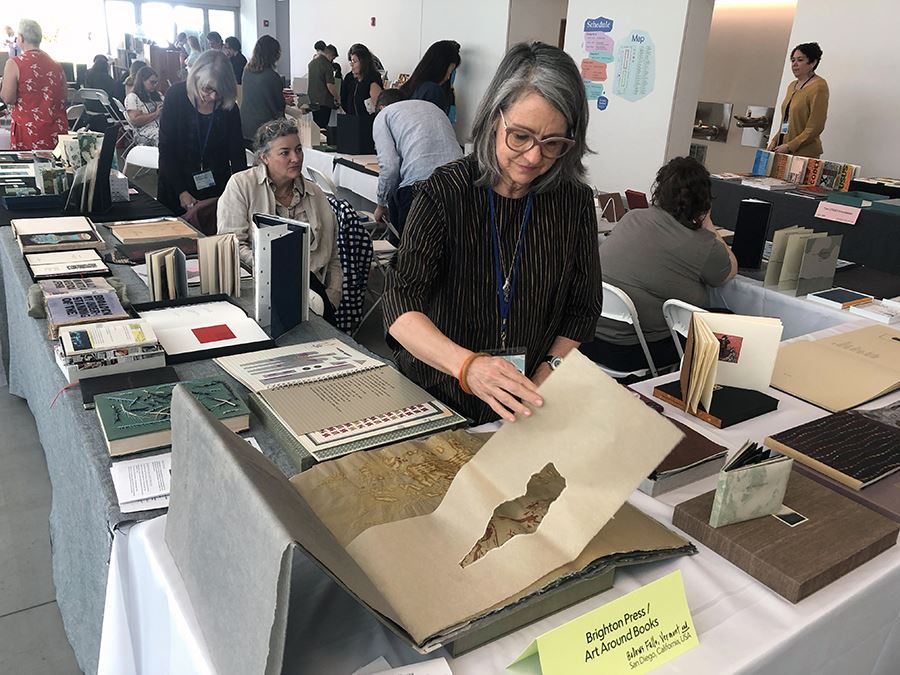
February 16th-19th, 2023 was the inaugural Tropic Bound fair and symposium: the first international biennial artist book fair set in Miami, Florida. As with many things, the pandemic changed the original timeline for Tropic Bound, causing the fair to be years in the making but therefore also highly anticipated. As I walked around the fair, elated to finally be amongst all of those incredible books and book-lovers, I found myself thinking about the way location (and the slightly more abstract notion of place) impacts the way one experiences artist books and the like.

Michele Burgess, Director of Brighton Press, showing her artist book The Blood Book
Location and place play a large role in the way something is contextualized, affecting the attitude people approach something with, the connections and associations people make with something, and the reception of that thing. The contextualization of artist books is mused over relatively often within the community, although mostly in regard to situating book arts among fine art or craft, where those lines should blur, and where distinction and labels are beneficial. But what about place?
How does a place like an artist book fair contextualize the artworks present in a way that a place like the Institute of Contemporary Art (located only a block from where Tropic Bound was) doesn’t? How do fellow exhibitors contextualize the work of other exhibitors at a fair? How does the city the work is seen in contextualize the work itself?

Aldeide Delgado, founder & director of Women Photographers International Archive, discussing works with Tayina Deravile
With the inundation of digital spaces becoming the new Normal during the pandemic, the general sense of place seemed to blur for everyone as events fluctuated from being solely location-dependent in-person events to accessible regardless of their base location through digital space, then occasionally utilizing a hybrid model and finally, now, often back to location-specific in-person events.

Naturally, seeing the work over the backdrop of Miami adds a different flavor than one would experience in a different location and Tropic Bound took place within Paradise Plaza in Miami’s Design District, surrounded by stores including Gucci, Louboutin, Balenciaga, and Givenchy. This may seem like a somewhat comical pairing when considering the differing price tags, but Miami’s Design District embraces contemporary fine art, both on the streets and within those luxury stores in a way that high-end retail districts in other cities do not. Furthermore, Miami’s Design District is situated just north of the Wynwood district: an arts district known for its colorful street art, skate punk aesthetics, and funky nightlife. Because of the nature of Miami as a place, the eclectic collection of the sixty-three exhibitors at the fair felt especially harmonious, with each table displaying an excellent range of niches within the book arts community that mimicked the ranges within the city. Exhibitors showed all manner of books: from chapbooks to fine press books, movable books, zines, portfolios, art objects, tools, and so much more – each feeling equally at home at Tropic Bound.

Dale Zine and O, Miami exhibitor tables
Furthermore, the influences present from the base locations of the exhibitors themselves added to the contextualization of the works. With Miami’s proximity to Central and South America, the fair included quite a few exhibitors from Mexico, Cuba, Argentina, Colombia, and Chile as well as featuring eight exhibitors from Florida itself. Additionally, the fair’s line-up seemed to hint at its East-Coast accessibility with the bulk of exhibitors coming from the Northeast, although there was still moderate representation from other locations as well. With this unique group dynamic, I felt like I noticed commonalities among areas of the book arts community that I would not have noticed among a different group of exhibitors. As I circled the fair, I couldn’t help but relate the works I saw on one table to the works on several others: noticing common themes within the topics contemporary makers are exploring in their projects, discovering similarities such as more makers using traditional print techniques, or spotting ways certain books changed the way I interpreted others.

Sarah Horowitz with Two Ponds Press showing her book titled Footprints
Tropic Bound left me inspired by everyone’s creativity, care, and passion for artist books and their tangents and I am excited to see how this new avenue for community continues to expand connections in its next iteration in 2025.
Beth Sheehan is an artist currently living in Tuscaloosa, AL. She teaches paper, print, and book workshops around the US and virtually. She co-authored the book Bookforms. Sheehan has also worked as a professional printer at Durham Press and Harlan and Weaver and was the Bindery Manager at Small Editions.

